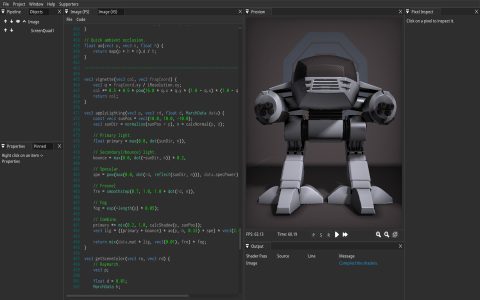Mechanisms for Accessing and Manipulating Data Within Shaders
Shaders operate by "reaching" for various types of data and applying computations to produce their output, such as pixel colors or vertex positions. Key mechanisms for this internal access and manipulation include:
-
Input Assembler Data (Primarily for Vertex Shaders):
Vertex shaders are the first programmable stage to typically process geometric data. They "reach" for per-vertex attributes supplied by the Input Assembler stage. Common attributes include:
- Vertex position (e.g.,
layout(location = 0) in vec3 aPos;) - Vertex normals
- Texture coordinates (UVs)
- Vertex colors
- Vertex position (e.g.,
-
Uniform Variables:
All shader stages can access uniform variables. These are read-only values set by the CPU application that remain constant for all invocations of a shader within a single draw call (or dispatch for compute shaders). Shaders "reach" for uniforms to get data like:

- Transformation matrices (Model, View, Projection)
- Material properties (e.g., albedo color, roughness, metallic)
- Light parameters (position, color, attenuation)
- Global scene parameters (e.g., time, camera position)
-
Textures and Samplers:
Fragment shaders, in particular, "reach into" texture memory using sampler objects. Textures provide image data, and samplers define how this data is accessed (e.g., filtering methods, addressing modes). This is fundamental for:
- Applying diffuse, specular, and normal maps
- Shadow mapping
- Environment mapping
- Post-processing effects
Vertex shaders can also access textures (Vertex Texture Fetch - VTF), though less commonly for primary texturing.
-
Varyings / Interpolators (Inter-Stage Communication):
Data is passed from an earlier programmable shader stage to a later one through output variables that become input variables for the next stage. For example, a vertex shader outputs values (e.g., transformed normals, UV coordinates) which are then interpolated across the surface of the primitive (triangle, line) by the rasterizer. The fragment shader then "reaches" for these interpolated values. These are often called "varyings" (OpenGL/GLSL) or "interpolators" (DirectX/HLSL).
-
Storage Buffers and Image Load/Store:
Modern graphics APIs allow shaders to "reach into" more general-purpose, writable memory buffers. Examples include Shader Storage Buffer Objects (SSBOs) in OpenGL/Vulkan, or Unordered Access Views (UAVs) in DirectX. This enables:
- Reading and writing arbitrary data structures.
- Implementing compute shader algorithms.
- Techniques like GPU-driven particle systems, order-independent transparency, or voxelization.
- Image load/store operations allow direct read/write access to specific texels in a texture without sampler filtering.
-
Built-in Variables:
Shading languages provide numerous built-in variables that shaders can "reach" for, offering information specific to the current invocation or stage. Examples include:

gl_Position(output from vertex/geometry/tessellation evaluation shaders defining clip-space position)gl_FragCoord(input to fragment shader: window-relative coordinates of the fragment)gl_VertexID,gl_InstanceID(inputs to vertex shader: index of vertex/instance)gl_PrimitiveID(input to geometry/fragment shader: index of the primitive)SV_Position(DirectX equivalent ofgl_Position)SV_Target(DirectX fragment shader output color)
-
Shader Intrinsics and Control Flow:
Internally, a shader "reaches" for its computational capabilities through built-in functions (intrinsics) for math (e.g.,
dot,normalize,cross,sin,exp,texture()), vector/matrix operations, and logical operations. Control flow structures likeif-elsestatements and loops (for,while) allow shaders to make decisions and iterate based on the data they have accessed.













